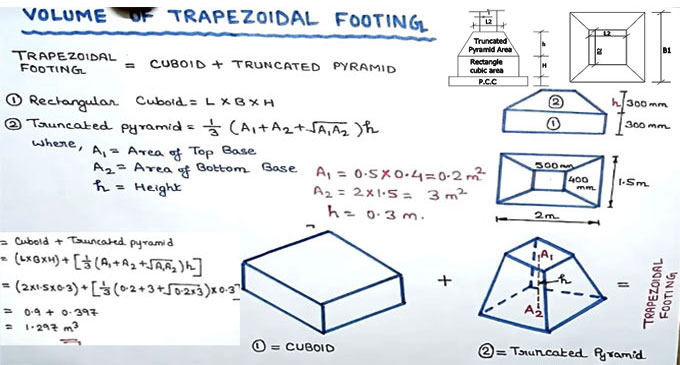
Step-by-step guidelines to calculate the volume of a trapezoidal footing

Isolated footings alias pad or spread footings are mostly found in shallow foundations with the intention of conveying and distribution of concentrated loads resulting from columns or pillars. Isolated footings either comprise of reinforced or non-reinforced material. For the non-reinforced footing, the height of the footing should be larger to maintain the required spreading of load.
To apply Isolated footings, there should not be fluctuating settlements under the whole building.
Necessity of materials for Isolated Footing : The following materials will be utilized for building up a isolated footing - Shutter Material, MS Rod, Binding Wire, Cover Block and Chair, Concrete.
Shutter Material for Isolated Footing: In isolated footing, generally wooden shutter materials are utilized. Often, steel shutter materials can also be applied.
This type of footing is utilized under the following conditions : Columns are not arranged narrowly. Fewer loads enforce on footings. The safe bearing strength of the soil is usually extreme.
In this construction video tutorial, one will learn how to make calculation for finding out the volume of Trapezoidal Footing at construction site.
Trapezoidal footing is formed by combining cuboid & truncated pyramid. Cuboid may be rectangular or square in shape. A special case of footings is the trapezoidal footing that may be utilized to bear two columns of unbalanced loads when distance outside the column of the massive load is restricted.
A trapezoidal footing is applied in such a manner that the center of gravity of the footing is located under the outcome of the loads. In that order, the distribution of contact pressure will be consistent.
Now, it is required to find out the volume of rectangular cuboid and truncated pyramid individually.
The formula for rectangular cuboid = L x B x H i.e. length x breadth x height
The formula for truncated pyramid = 1/3 (A1 + A2 + vA1A2)h
Here, A1 = Area of top base
A2 = Area of bottom base
h = Height
To learn the detail calculation process, watch the following video tutorial.
Video Source: L & T - Learning Technology


